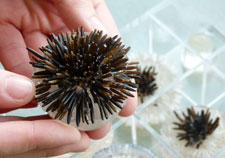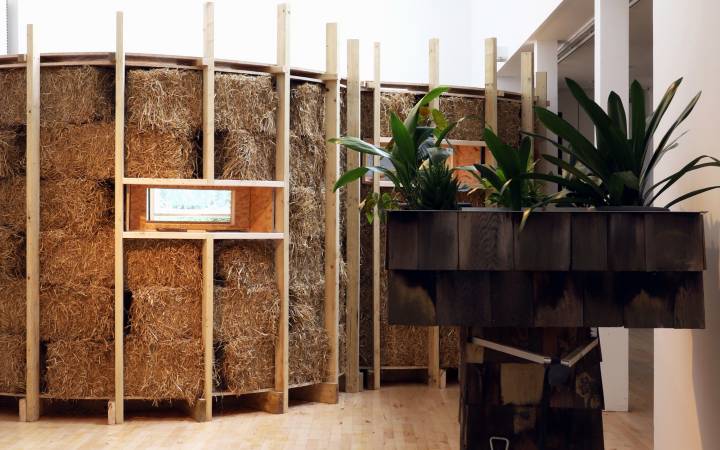Futuristic footwear ensures student is a shoe-in at Vauxhall Fashion Scout
Posted Monday 17 September 2012
 A Kingston University student has turned the traditional high heel on its head for a project unveiled during London Fashion Week. Julia Skergeth's concept for a piece of towering footwear made using rice, silicon and bio-resin has won her a place at the prestigious Vauxhall Fashion Scout showcase, even though she is only in the first year of her postgraduate studies.
A Kingston University student has turned the traditional high heel on its head for a project unveiled during London Fashion Week. Julia Skergeth's concept for a piece of towering footwear made using rice, silicon and bio-resin has won her a place at the prestigious Vauxhall Fashion Scout showcase, even though she is only in the first year of her postgraduate studies.
She came up with the idea after InCrops - a company spearheading the commercialisation of bio-renewable materials - challenged students on Kingston University's MA Fashion course to create sustainable luxury items. To meet the brief, Julia focused on alternative plant-based materials, but also caught the judges' attention by flipping the typical sloping shape of the high heel back to front.
"I just love crystals, diamonds and all the sparkly embellishments that finish so many luxury fashion items," Julia, originally from Salzburg in Austria, said. "This project, however, asked us to create sustainable luxury, so I had to really think about how I could keep the materials and approach green but still make eye-catching designs."
Keen cook Julia opted to try rice as her alternative bling, but knew it wouldn't wear well. Instead, she experimented using the shape of the rice on a template, spending weeks gluing on individual grains to create intricate geometric shapes. Pouring silicon over the rice-covered shoe shape, Julia was left with a mould in which to place the bio-resin. "The grains of rice left an imprint in the silicon mould which was revealed again when I filled it with bio-resin," the 21 year old explained. "Bio-resin dries crystal clear, so I also took the opportunity to feature the rice again by pouring it into the liquid. Floating to the bottom, it reinforced the spiky shapes it had already created on the exterior."
 In another quirky twist, Julia decided to postion the heel at the front of the shoe, with the toes slightly higher than the rear. "Shoe design has gone crazy. Heels have got higher and platforms have sent footwear to even dizzier heights," the budding womenswear designer said. "Some shoes have even done away with the heel altogether. It seemed to me that the rulebook had already been thrown away and that I could try anything."
In another quirky twist, Julia decided to postion the heel at the front of the shoe, with the toes slightly higher than the rear. "Shoe design has gone crazy. Heels have got higher and platforms have sent footwear to even dizzier heights," the budding womenswear designer said. "Some shoes have even done away with the heel altogether. It seemed to me that the rulebook had already been thrown away and that I could try anything."
As the project took shape, Julia dismantled odd shoes that she had received from buyers and visited cobblers for advice. "Most doubted I would be able to do it, but that made me even more determined. So many shoes on the high street are almost impossible to walk in anyway, so I just wanted to take the opportunity to play with the design," she said.
Julia found companies were intrigued by her designs and she attracted sponsorship from silicon and resin manufacturers. She was even given some free rice from major manufacturer Tilda. "Materials in fashion design can be so expensive, which is why I found this project a great test of my business acumen as well as my design skills," she said. "Made of multiple materials, such as rubber, leather, PVC and metal, shoes aren't sustainable by nature so that added to the challenge."
 Dr Liliya Serazetdinova from InCrops, which is part of the Adapt Low Carbon Group at the University of East Anglia, said she hoped the activity would inspire more designers to use bio-based renewable materials in luxury goods as well as everyday products. "This year's students widened the scope of the project brief and thought about how the processes and technologies involved in the manufacture of luxury goods could be low carbon too, in addition to the materials used," she said. "The fashion industry has a high environmental footprint and is responsible for a significant amount of waste, but these exciting designs use natural and renewable materials to create stunning luxury goods. At InCrops, we've been really impressed with how the students have addressed this challenge," Dr Serazetdinova said.
Dr Liliya Serazetdinova from InCrops, which is part of the Adapt Low Carbon Group at the University of East Anglia, said she hoped the activity would inspire more designers to use bio-based renewable materials in luxury goods as well as everyday products. "This year's students widened the scope of the project brief and thought about how the processes and technologies involved in the manufacture of luxury goods could be low carbon too, in addition to the materials used," she said. "The fashion industry has a high environmental footprint and is responsible for a significant amount of waste, but these exciting designs use natural and renewable materials to create stunning luxury goods. At InCrops, we've been really impressed with how the students have addressed this challenge," Dr Serazetdinova said.
Kingston University fashion lecturer Joanna Norman said Julia's designs had shown how bio-materials and waste could be transformed into covetable items. "Julia has experimented during the past year with pistachio shells and coffee beans on shoes, but her rice and bio-resin design has created a truly intricate and sustainable fashion statement," Ms Norman said.
Several other new ideas had flourished as a result of the collaboration with InCrops, she added. Student Jen Hope had taken scrap patent leather and, using laser engraving, created intricate patterns to reveal a multi-layered effect that imitated the look of pottery and lacquered wood. She had also experimented with vegetan - a vegetable-tanned leather - and second-hand denim to make a bag. Elizabeth Gilbey, meanwhile, was inspired by digital draping - a form of virtual pattern-cutting in which designs are digitally projected on to the body - and had recreated a lace effect using organic yarns, bamboo, Tencel and jersey for her womenswear designs.
- Find out more about studying MA Fashion at Kingston University.
Contact us
General enquiries:
Journalists only:
- Communications team
Tel: +44 (0)20 8417 3034
Email us



